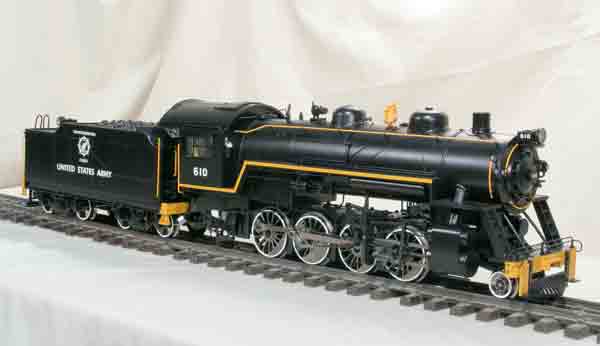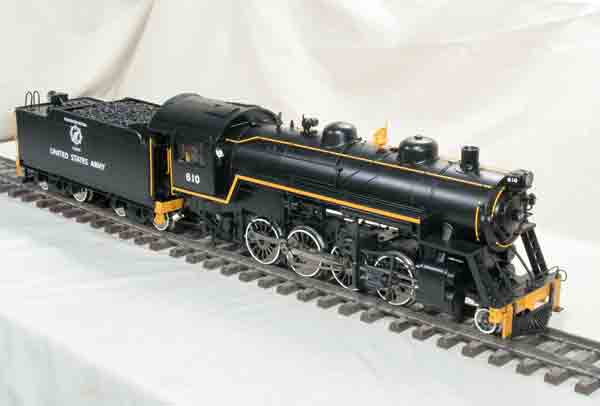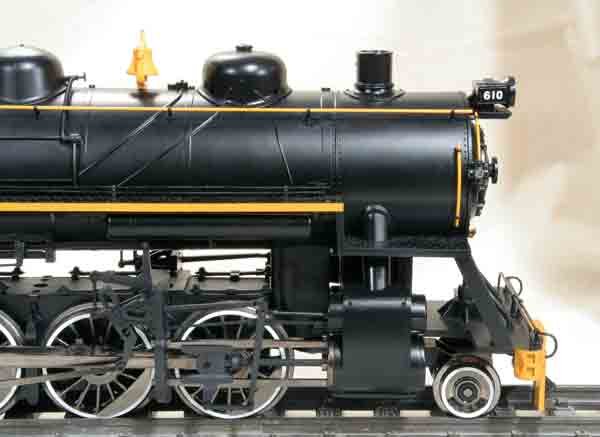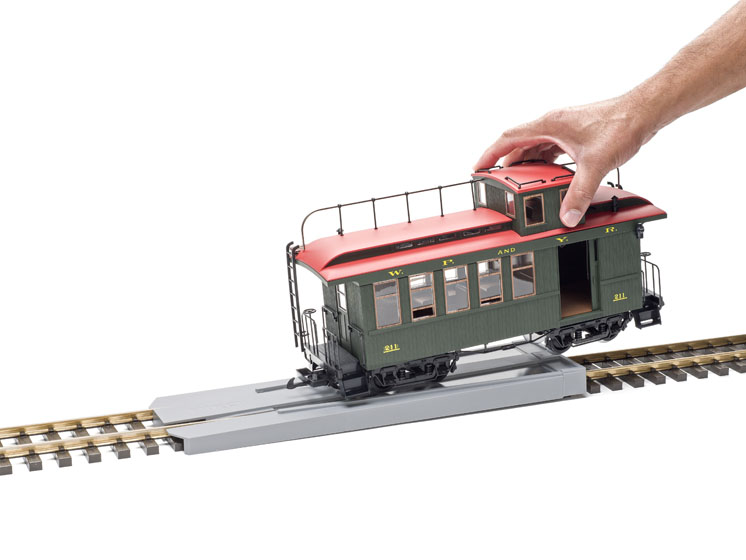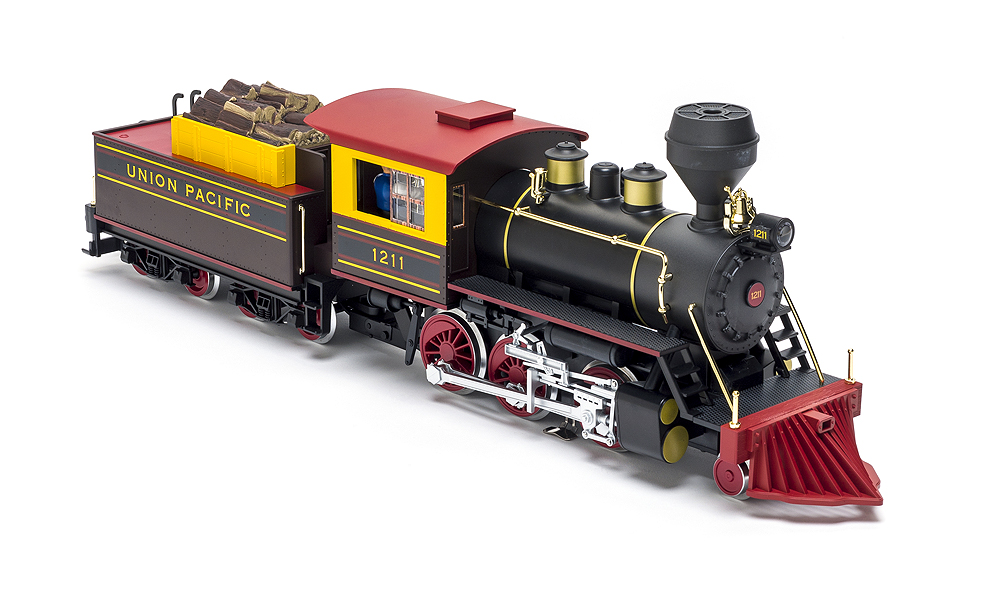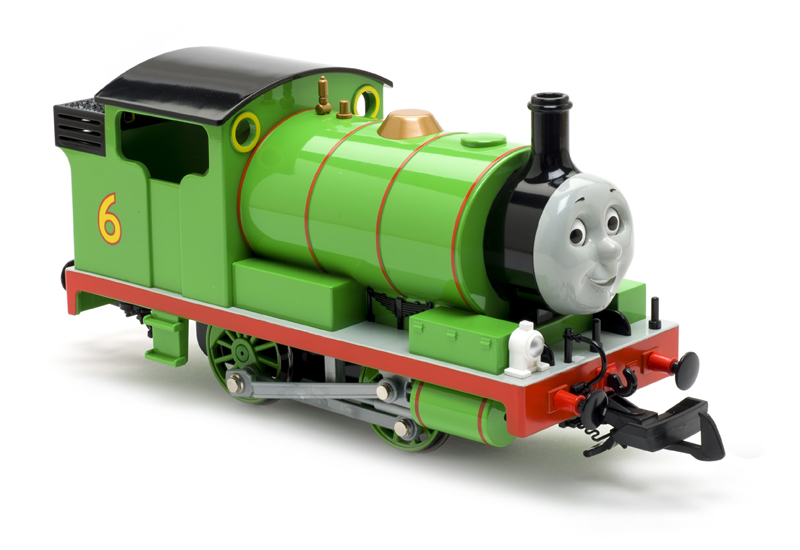Aristo-Craft Trains
698 S. 21st St.
Irvington NJ 07111
Price: $891
Website: www.aristocraft.com
Plastic model of a 2-8-0, based on the Baltimore & Ohio E-27-class Consolidations. Dimensions: length, 29″ over couplers (70′ scale); width, 4″ (9.6′ scale); height, 6.5″ to top of stack (15.7′ scale). Minimum radius, 4′ (8′ diameter)
Pros: Smooth, quiet motor and gearboxes; matches prototype well; good drawbar pull
Cons: Plastic column used to attach boiler to chassis visually distracting; plastic components in valve gear look cheap and flimsy; front coupler cannot fit on pilot beam with cowcatcher in place
By the mid 1900s, the Baltimore & Ohio Railroad already had a sizable fleet of 2-8-0s in service. Requiring heavier versions to meet their growing needs, the railroad turned to Alco for a new design on an old theme. The result was what they called the E-27-class Consolidation. This locomotive developed over 50,000 pounds of tractive effort. Numerous sub-classes emerged, as changes and technological refinements were made. In all, nearly 250 E-27-class locomotives were built, many lasting until the end of steam. Sadly, none have been preserved.
Because there were so many variations within the E-27 class, it’s difficult, if not impossible, to say which class Aristo-Craft’s model is based upon, if indeed it is based upon a single specific locomotive. Overall, though, Aristo-Craft has done an admirable job of capturing the general look of the class, giving the large-scale market that which it has been lacking for so long; a mid-sized steam engine that’s representative of a common—arguably the most common—wheel arrangement made.
The locomotive looks impressive. It’s well proportioned and is a good overall size—not too big, not too small. It will fit in well on a “typical” garden railroad where larger locomotives may overpower the scene. Perhaps the one physical attribute of this locomotive that stands out as being different from the rest is the open space between the drivers and the boiler. On most of the 1:29 scale, standard-gauge steam locomotives currently on the market, the locomotive’s firebox is located behind the rear driving wheel. This brings the tops of the drivers close to the bottom of the boiler. On the prototype for this (and other) 2-8-0s, the firebox is located above the rear drivers, so there’s a much taller space between the drivers and the boiler. This is entirely prototypical.
As I mentioned earlier, Aristo-Craft did a good job replicating the prototype E-27 locomotive. Compared to published drawings (and taking into account the variations in specific details that existed within the class), most dimensions and details are very close. The drivers are slightly small (by about four scale inches). Aristo-Craft used the same wheels and gearboxes on this locomotive that they used on their 2-8-2 and 2-8-8-2.
The engine is well detailed, with a mix of molded-in and separate piping along the boiler. While I don’t like molded-in piping on boilers, the difference between the two isn’t terribly noticeable from more than a few feet away. Rivet detail is crisp, and there’s enough overall detail to satisfy all but the choosiest of modelers. There’s a proper crew seated inside the cab, so your locomotive won’t look like a runaway heading down the track.
There are some curiosities, though. As the locomotive comes out of the box, there’s a cowcatcher on the front pilot, but no front coupler. If you want to attach the front coupler (included in the box), you must first remove the cowcatcher. It won’t go back on once the coupler is attached. If you want the front coupler and a proper cowcatcher, you’ll have to do surgery.
Under the boiler, just to the rear of the smokebox, is a strange plastic box or column extending from the bottom of the boiler to the frames. This is there to hold the motor block to the boiler. I don’t understand the logic of doing things that way, as opposed to just lengthening the frame and using the firebox to secure things, which is pretty much universal practice on other locomotives.
The valve gear is well done in terms of detail but, with half of it being metal and the other half unpainted black plastic, the visual differences between the two give it a somewhat flimsy appearance. Model locomotives have been successfully using plastic valve gear for decades in this scale but, to me, the combination makes the valve gear look toylike. A proper coat of paint on the valve gear (as well as on the shiny metal drivers) will help balance things out.
The tender is well done. A removable coal load exposes the PC board inside, containing Aristo-Craft’s “Plug-and-Play” socket. It’s easily accessible, though you’ll probably want to remove the shell if you’re going to install third-party electronics. Sharing space with the PC board is a 3″ speaker that sits on the floor of the tender directly under the PC board. There are metal weights on the floor, both at both the front and back of the tender. Even with all that, there’s still ample room for batteries. The tender drawbar is adjustable, so you can alter the spacing between the engine and tender to suit your needs.
All of the wheels on the locomotive are a shiny, dark metal, with white painted rims. While I prefer to see painted wheel faces, as they’re more realistic, it’s not something Aristo-Craft does. (It’s also easily remedied by the modeler.) The back-to-back spacing on the drivers was consistently 1.560″, which is at the narrow end of NMRA specs but within tolerances. Each axle is directly powered by the motor, and each axle has some side-to-side and a bit of up-and-down play to compensate for uneven track. The pilot wheel and tender wheels have a back-to-back spacing of 1.575″, which is on target for NMRA and G1MRA. Tender and pilot wheels have thinner flanges, which accounts for the difference in back-to-back spacing. I’d prefer to see a consistent wheel profile but, if the engine stays on the track, who’s to argue?
I was impressed with the engine’s operating characteristics. Wheels started turning at only about 1.5V, and the locomotive broke into a slow crawl at that voltage. Folks wanting to do switching operations with this locomotive will be pleased with its performance. At 22V, it topped out at around 60 scale miles per hour, which was probably about right for this kind of locomotive. Motor and gears are quiet. Running light, the motor drew around 0.5 amps, while, slipping, it drew 1.5. Stalled, it drew 4.4 amps. Drawbar pull is around two pounds, or enough for a train of around 26 average freight cars on straight, level track.
Lights on the locomotive came on at around the same time the locomotive began moving but didn’t reach full intensity until around 6V (they’re regulated to 5V). The headlight and class lamps are wired together, so they’re always on when the locomotive is moving (forward or backward). The light on the tender is directional, and only illuminates when the locomotive is running in reverse. There’s also a light in the cab to help the crew see.
Standard-gauge modelers have been clamoring for a decent mid-sized steam locomotive for some time and, from when it was announced, this locomotive has likewise been a long time coming. Overall, I think it fills the niche nicely. It runs slowly and smoothly and I’ve enjoyed seeing the motion of the side rods as it drifts by. If you’re modeling between 1900 and 1950, chances are good that your railroad had at least one—if not a fleet—of similar 2-8-0s. Out of the box, Aristo-Craft’s locomotive is pleasing enough. With a little paint, some extra details here and there, and perhaps a bit of judicious weathering, this locomotive has the potential of quickly and deservedly winning the title of “favorite workhorse” on your railroad.





